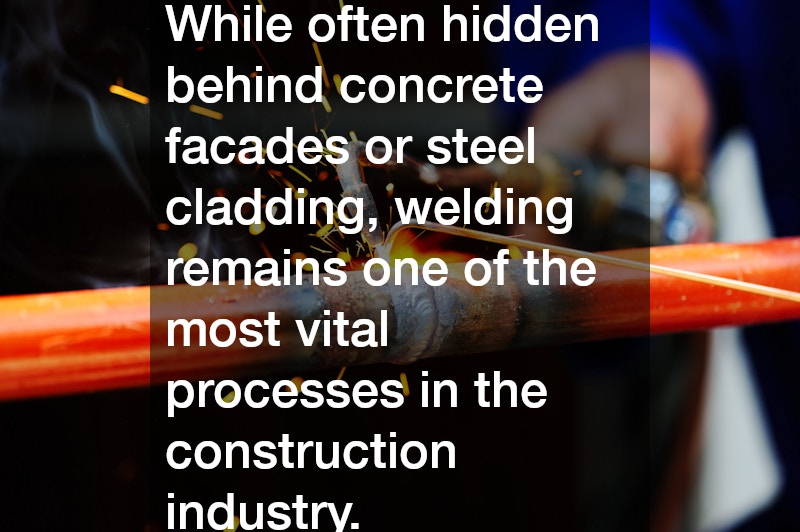In the world of construction, few trades are as essential and impactful as welding. From towering skyscrapers to robust bridges and modern residential builds, welded joints form the hidden skeletons that hold these structures together.
Welding is not just a practical trade but a foundational process that enables the creation of strong, reliable, and long-lasting structures. Understanding its role in the construction industry highlights why welding is far more than sparks and steel—it is the backbone of structural integrity, safety, and progress.
Structural Integrity & Load-Bearing Strength
The most fundamental reason welding plays such a crucial role in construction is its contribution to structural integrity. When different steel components need to be joined together in buildings, tunnels, or roadways, welding offers a seamless and permanent solution. Unlike mechanical fasteners such as bolts or rivets, welded joints do not introduce additional holes or breaks in the material, which can weaken the overall structure. Instead, welding fuses the metal surfaces at a molecular level, creating a joint as strong as—or sometimes stronger than—the original materials.
For load-bearing structures such as beams, columns, and girders, this strength is not optional but essential. A poorly joined section of a load-bearing element could lead to catastrophic failure, especially under stress or heavy loads. The durability of welding also ensures that structures can withstand long-term stressors, including wind, seismic activity, and heavy use, all of which are typical conditions on Australian construction sites. This contributes directly to the safety of occupants and the longevity of the built environment.
Versatility Across Construction Applications
Welding’s importance also lies in its unmatched versatility. The construction industry requires materials and methods that can adapt to different project demands. Welding is employed across a wide array of applications, from fabricating steel frameworks to securing rebar in concrete to assembling prefabricated metal components. Whether in the controlled environment of a fabrication workshop or on the unpredictable setting of a building site, welding can be tailored to suit the task at hand.
Modern construction projects often require unique architectural designs and customised metalwork that cannot be achieved using prefabricated parts alone. Welding allows for on-site adjustments and creative problem-solving, which are vital when dealing with last-minute design changes or site-specific challenges. Additionally, a variety of welding techniques—such as MIG, TIG, and arc welding—can be selected based on the materials and project specifications, offering a high degree of flexibility. This adaptability makes welding an indispensable part of contemporary construction practices.
Enabling Innovation & Sustainability
As Australia continues to shift towards more sustainable construction practices, welding plays an increasingly significant role in enabling green building innovations. For example, modular construction—a method gaining popularity for its cost-efficiency and reduced environmental impact—relies heavily on welding for the assembly of prefabricated units. These modules, built off-site and later joined together on-site, must be precisely welded to ensure uniformity and strength.
Furthermore, the use of recycled steel and other metals in construction is becoming more prevalent. Welding allows these materials to be reformed and reused without compromising the strength of the final product. In this way, welding contributes directly to reducing waste and promoting the circular economy within the construction industry. By enabling the use of sustainable materials and construction methods, welding supports Australia’s broader environmental goals and green building standards.
Skilled Workforce & Industry Development
The significance of welding in construction also extends to workforce development and economic contribution. As one of the key trades within the construction and manufacturing sectors, welding provides thousands of skilled jobs across Australia. These roles are not only vital for completing current projects but also for supporting future infrastructure growth and innovation. Training programs, apprenticeships, and certifications ensure that welders meet national safety and quality standards, reinforcing the importance of skilled labour in maintaining construction excellence.
Moreover, as infrastructure demands grow—particularly in urban centres and regional developments—so too does the need for competent welders. This demand underpins a significant portion of the Australian economy, especially in resource-rich states where construction is closely tied to mining and industrial expansion. Welding, therefore, serves as a cornerstone for national development and economic resilience.
The Unseen Framework of Modern Construction
While often hidden behind concrete facades or steel cladding, welding remains one of the most vital processes in the construction industry. Its ability to deliver strength, versatility, and sustainability ensures that modern structures are safe, functional, and future-ready. From high-rise developments in Sydney to regional infrastructure projects across Western Australia, welding silently enables the progress of construction across the nation.
As the industry continues to evolve with new technologies and sustainable practices, welding will remain at the heart of these transformations. Its role in binding materials, supporting architectural vision, and building for durability cannot be overstated. Understanding why welding is important in construction is not just a matter of technical appreciation—it’s a recognition of the role it plays in shaping the built world around us.

